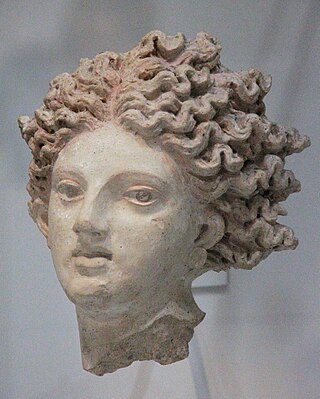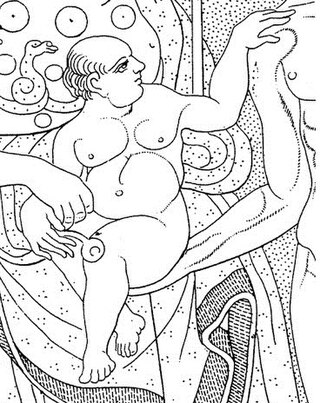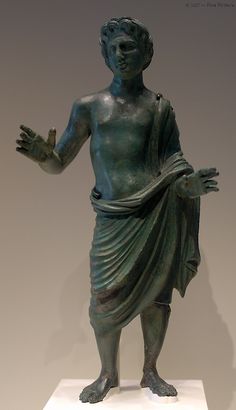
Etruscan religion comprises a set of stories, beliefs, and religious practices of the Etruscan civilization, heavily influenced by the mythology of ancient Greece, and sharing similarities with concurrent Roman mythology and religion. As the Etruscan civilization was gradually assimilated into the Roman Republic from the 4th century BC, the Etruscan religion and mythology were partially incorporated into ancient Roman culture, following the Roman tendency to absorb some of the local gods and customs of conquered lands. The first attestations of an Etruscan religion can be traced back to the Villanovan culture.

Aita, also spelled Eita, is an epithet of the Etruscan chthonic fire god Śuri as god of the underworld, roughly equivalent to the Greek god Hades.
In Etruscan religion, Fufluns or Puphluns was a god of plant life, happiness, wine, health, and growth in all things. He is mentioned twice among the gods listed in the inscriptions of the Liver of Piacenza, being listed among the 16 gods that rule the Etruscan astrological houses. He is the 9th of those 16 gods. He is the son of Semla and the god Tinia. He was worshipped at Populonia and is the namesake of that town.

Menrva was an Etruscan goddess of war, art, wisdom, and medicine. She contributed much of her character to the Roman Minerva. She was the child of Uni and Tinia.
In Etruscan religion and myth, Thalna was a divine figure usually regarded as a goddess of childbirth. Determinate gender, however, is not necessarily a characteristic of Etruscan deities, and Thalna is also either depicted as male, or seems to be identified as a male figure because of the placement of names around a scene. Her other functions include friendship and prophecy. Her name may mean "growth, bloom." She appears in Etruscan art in the company of Turan, Tinia, and Menrva.

Tinia was the sky god and the highest deity in Etruscan religion, equivalent to the Roman Jupiter and the Greek Zeus.

In Etruscan religion, Hercle, the son of Tinia and Uni, was a version of the Greek Heracles, depicted as a muscular figure often carrying a club and wearing a lionskin. He is a popular subject in Etruscan art, particularly bronze mirrors, which show him engaged in adventures not known from the Greek myths of Heracles or the Roman and later classical myths of Hercules.

The Tabula Capuana, is an ancient terracotta slab, 50 by 60 cm, with a long inscribed text in Etruscan, dated to around 470 BCE, apparently a ritual calendar. About 390 words are legible, making it the second-most extensive surviving Etruscan text. The longest is the linen book (Liber Linteus), also a ritual calendar, used in ancient Egypt for mummy wrappings, now at Zagreb. The Tabula Capuana is located in the Altes Museum, Berlin.

Uni is the ancient goddess of marriage, fertility, family, and women in Etruscan religion and myth, and was the patron goddess of Perugia. She is identified as the Etruscan equivalent of Juno in Roman mythology, and Hera in Greek mythology. As the supreme goddess of the Etruscan pantheon, she is part of the Etruscan trinity, an original precursor to the Capitoline Triad, made up of her husband Tinia, the god of the sky, and daughter Menrva, the goddess of wisdom.

The Liver of Piacenza is an Etruscan artifact found in a field on September 26, 1877, near Gossolengo, in the province of Piacenza, Italy, now kept in the Municipal Museum of Piacenza, in the Palazzo Farnese.

Usil is the Etruscan god of the sun, shown to be identified with Apulu (Apollo). His iconic depiction features Usil rising out of the sea, with a fireball in either outstretched hand, on an engraved Etruscan bronze mirror in late Archaic style, formerly on the Roman antiquities market. On Etruscan mirrors in the Classical style, Usil appears with an aureole.

In ancient Roman religion and mythology, Mars is the god of war and also an agricultural guardian, a combination characteristic of early Rome. He is the son of Jupiter and Juno, and was pre-eminent among the Roman army's military gods. Most of his festivals were held in March, the month named for him, and in October, the months which traditionally began and ended the season for both military campaigning and farming.
Cel was the Etruscan goddess of the earth. On the Etruscan calendar, the month of Celi (September) is likely named for her. Her Greek counterpart is Gaia and her Roman is Tellus.

Catha is a female Etruscan lunar or solar deity, who may also be connected to childbirth, and has a connection to the underworld. Catha is also the goddess of the south sanctuary at Pyrgi, Italy.
Leinth is an Etruscan deity. Within Etruscan iconography, it is difficult to distinguish mortals from divine figures without inscriptions. Inscriptions to the god Leinth have only been identified on two bronze mirrors and a single fragment of ceramic, found within an artisan’s zone on an Etruscan site in Italy. It is difficult, with such little evidence, to determine what may seem to be even the most rudimentary qualities of the deity, because the Etruscans did not consistently assign specific genders or attributes to their gods. Leinth appears both as a male and a female on two different bronze mirrors, and aside from the inscription, there seem to be no distinguishing traits to connect the figures.

Epiur is an Etruscan mythological figure that appears on bronze Etruscan engraved mirrors. He is shown as an infant that has the face of a young man. He is also often winged and being held by Hercle or Menrva, who are charged with the protection and care of infants. He is also often shown to be presented to other gods.

Lur is an Etruscan underworld deity with not much known history. Lur does not have many depictions but the ones that have been found show the deity as a male. He has been noted to be associated with a prophetic nature, while also bearing oracular and martial characteristics. He has been linked to another deity by the name of Laran, which, it has been suggested, is where Lur derives his name from. The context of the name has been associated with darkness and the underworld. A fifth century vase found near a sanctuary in San Giovenale bears an inscription that translates: "I am Lurs, that of Laran." Another inscription has been found with the spelling lartla, noting relations to a Lar, which gives a label to Lur that describes features of protection. The name may be related to Latin luridus "pale".

The Lead Plaque of Magliano, which contains 73 words in the Etruscan language, seems to be a dedicatory text, including as it does many names of mostly underworld deities. It was found in 1882, and dates to the mid 5th century BC. It is now housed in the National Archaeological Museum in Florence.

Apulu, also syncopated as Aplu, is an epithet of the Etruscan fire god Śuri as chthonic sky god, roughly equivalent to the Greco-Roman god Apollo. Their names are associated on Pyrgi inscriptions too. The name Apulu or Aplu did not come directly from Greece but via a Latin center, probably Palestrina.















